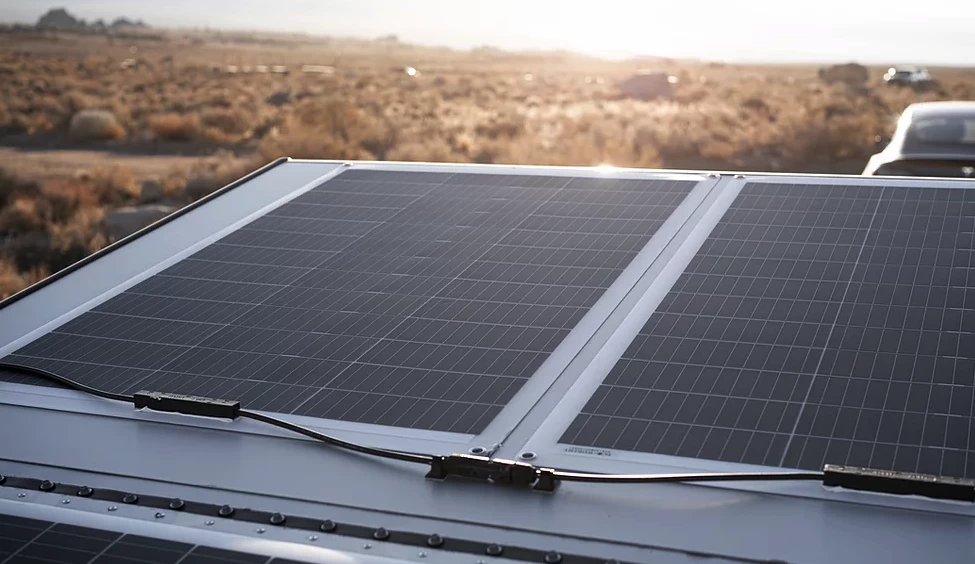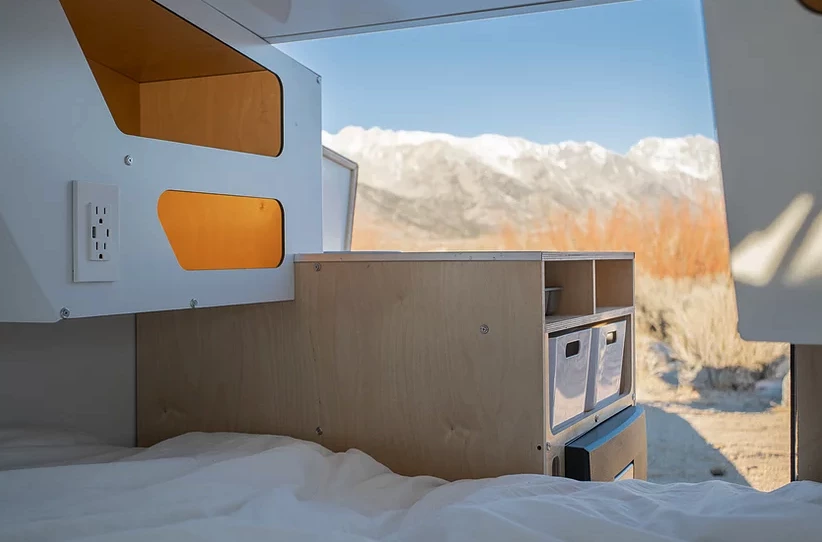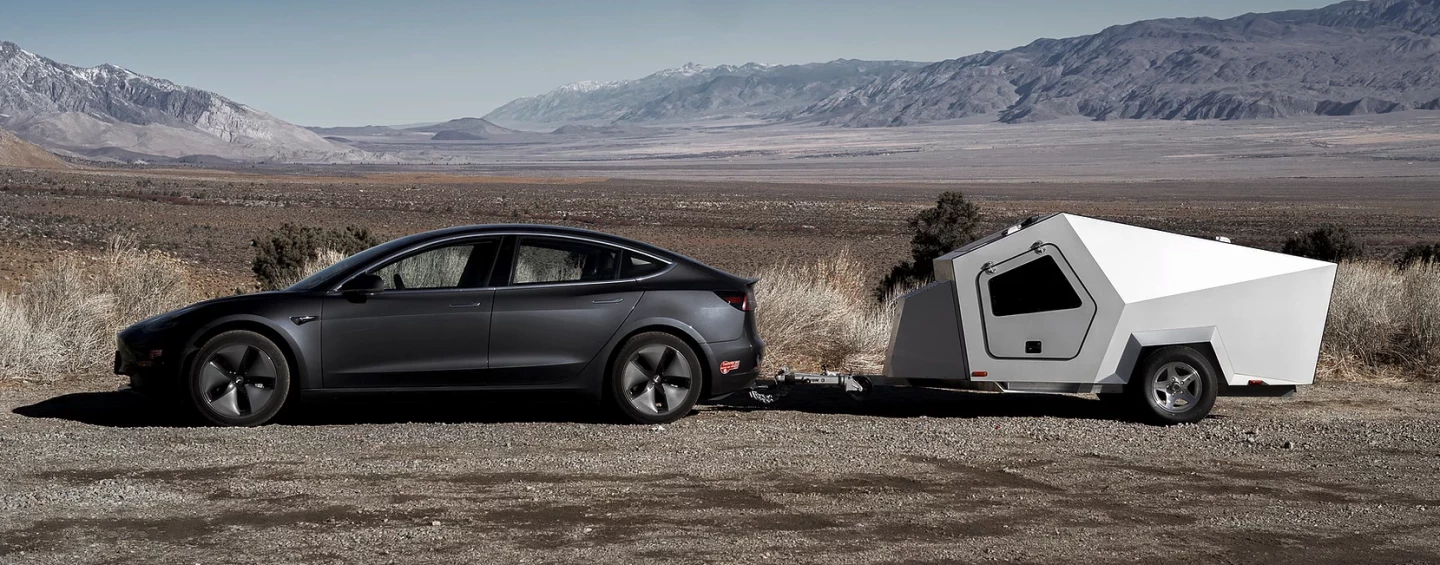In 2019, California startup Polydrops reimagined the teardrop trailer as an angular mobile personal space designed to escape the world. Now it's back with a more comfortable, fully equipped personal space specced to be something of a towable hotel room. The new P17A supports off-grid living with a powerful solar-charged lithium battery bank, all-weather battery-powered HVAC system and available kitchenette. It's a comfortable, climate-controlled tiny living space in which to disconnect for up to six days at a time.
The 13.6-foot (4.1-m) P17A trailer looks much the same as the slightly shorter original Polydrop when riding behind a tow vehicle. But Polydrops has done some considerable reshuffling behind the aluminum skin to optimize weight and layout around increased autonomy. The trailer's standard 2.4-kWh lithium-iron-phosphate battery gets integrated flatly into the heart of the aluminum frame, much like an EV skateboard chassis. This keeps weight as low and evenly distributed as possible.
Buyers looking for added battery power can double that pack to 4.8 kWh or jump up to the top-tier 12-kWh pack necessary to meet Polydrops' six-day off-grid estimate. Whatever option the buyer chooses, roof-mounted solar panels keep the battery charging at times it's not hooked up to external power. Polydrops equips the P17A with a standard 260-watt solar system, and buyers can double that setup for 520 watts. A pure sine wave inverter delivers power to the AC outlets and appliances.

The big layout difference between the P17A and previous Polydrops designs comes in the loss of the standard tailgate galley. The tailgate survives, but instead of opening up to a full-width kitchen, it opens directly to the main cabin and its full-size mattress. This saves weight on kitchen structural elements and appliances while giving the trailer a breezier, more scenic space in which to relax.
For those who want a kitchen, Polydrops offers an optional partial-width kitchenette with 20-L fridge drawer, 1,300-W induction cooktop, and hand-pump sink piped to 6-L fresh and gray water tanks. The kitchen also includes storage bins and trays for utensils, cookware and dishes. Its partial width prevents the usual walled-off bed/galley teardrop split, keeping interior access from the tailgate open.

The remainder of the layout is quite basic, even by teardrop trailer standards. Aft of each of the two gullwing side entries is an open shelf unit that looks like an upside-down wheel well cover. Each has a variety of front and side-access shelf space, and the driver-side unit sits in front of a taller wardrobe good for hanging up clothes. Bluetooth speakers mounted to the face of each shelving unit pair into a stereo system.
The biggest new addition is the complete HVAC system that runs off the batteries. It includes a heater, air conditioner and vent fan to keep the cabin comfortable through all seasons and weather. The extra-thick insulation package ups R-value to R-14 to properly isolate the cozy environment inside from the weather outside.

Polydrops uses some specific numbers to reach its full six days of autonomy. First off, buyers looking for that kind of off-grid runtime will want to upgrade to the top 12-kWh battery option. From there, Polydrops calculates three hours of daily heater or A/C use, four hours of LED lighting, 10 hours of refrigeration and seven hours of Bluetooth speaker play.
Different users will of course use electricity very differently. Thinking about our own camping, we'd rarely use climate control throughout the year, save for running heat during unexpected sub-freezing temperatures in spring or fall (we wouldn't anticipate doing much winter camping in a tiny trailer). We'd have the refrigerator plugged in and running on battery throughout the day, save for days we plugged into the tow vehicle or shore power. We can't imagine playing anywhere near seven hours of music on a daily basis.
At 1,200 lb (544 kg) dry, the P17A weighs well more than Polydrop's 760-lb (345-kg) debut 2019 trailer, but it's still sized for small car and electric vehicle towing. Polydrops doesn't go full Bowlus with an emergency charge feature, but it aims its weight and aerodynamic optimization at efficient towing for electric cars, paneling over the underbody for better aero performance.

Polydrops claims it was able to achieve a range of 245 miles (394 km) towing the P17A with a 2018 Tesla Model 3 Long Range, an electric sedan with a 310-mile (500-km) EPA-estimated range. Its results are based on a single 400-mile (644-km) trip on mostly California highway, the company explains, and mileages will vary with different vehicles, routes and drivers.
The P17A starts at $24,990 for the base spec with 2.4-kWh battery, 260-watt solar charging and full HVAC system. A top model with 12-kWh and 520-W solar prices in at $33,790, while the kitchenette is available as an $1,850 add-on, the Bluetooth speakers, $500. Polydrops announced the opening of orders earlier this week.














